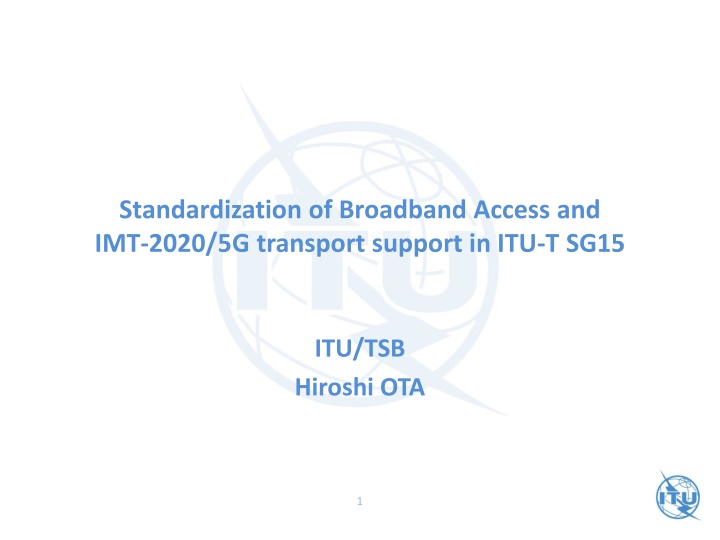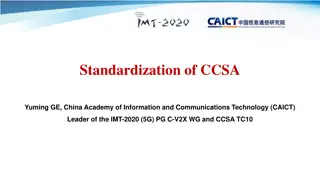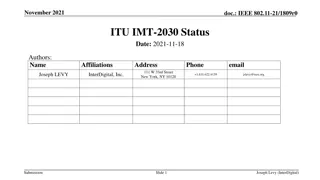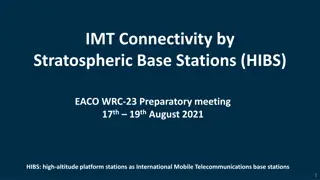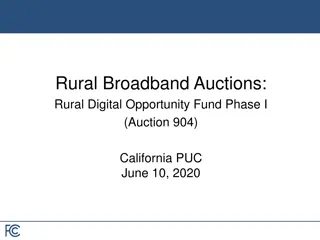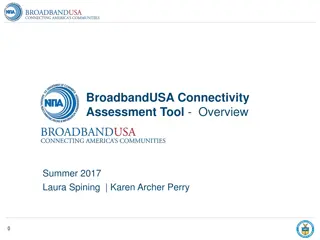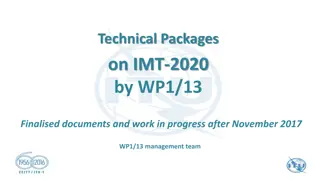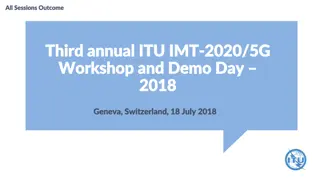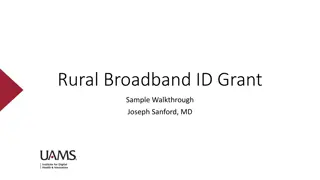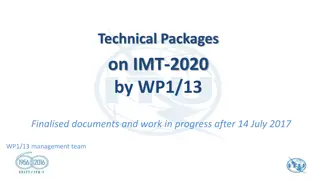Standardization of Broadband Access and IMT-2020/5G Transport Support
Developed by ITU-T SG15, this content delves into standards for broadband access like PON systems, optical fiber versus copper, recent progress in PON standards, coexistence of ITU PON technologies, and metallic access solutions in the telecommunications industry.
Uploaded on Mar 12, 2025 | 1 Views
Download Presentation

Please find below an Image/Link to download the presentation.
The content on the website is provided AS IS for your information and personal use only. It may not be sold, licensed, or shared on other websites without obtaining consent from the author.If you encounter any issues during the download, it is possible that the publisher has removed the file from their server.
You are allowed to download the files provided on this website for personal or commercial use, subject to the condition that they are used lawfully. All files are the property of their respective owners.
The content on the website is provided AS IS for your information and personal use only. It may not be sold, licensed, or shared on other websites without obtaining consent from the author.
E N D
Presentation Transcript
Standardization of Broadband Access and IMT-2020/5G transport support in ITU-T SG15 ITU/TSB Hiroshi OTA 1
ITU-T SG15 - mandate ITU-T SG15 is responsible for the development of standards standards on: home network and power utility network infrastructures access network optical transport network equipment systems optical fibres and cables and their related installation maintenance management instrumentation and measurement techniques control plane technologies test to enable the evolution toward intelligent transport networks, including the support of smart-grid applications. 2
Broadband access optical fiber or copper? Q2/15: Optical systems for fibre access networks PON (Passive Optical Network) Q4/15: Broadband access over metallic conductors xDSL (ADSL, VDSL) FTTDp (G.fast, G.mgfast)
What is PON? Passive Optical Network (PON) system A point-to-multipoint optical communication system. The most popular system to realize Fiber To The Home (FTTH) in the world. Multiple (e.g. 16 to 128) ONUs communicate with an OLT via optical splitter(s). Central office ONU1 TDMA ONU2 OLT Optical splitter Reference point ONU n Reference point OLT: Optical Line Terminal, ONU: Optical Network Unit TDMA: Time Division Multiple Access
Coexistence of ITU PON Technologies using WDM XGS-PON XGS-PON OLT G.652 Fiber G-PON CE 1xN 1577/1270 nm* CE** (Co-Existence Element) NG-PON2 Example of a type of Coexistence Element defined in Appendix I of G.984.5 1490/1310 nm* G-PON OLT 1600/1544 nm* NG-PON2 OLT *Downstream and Upstream Center Wavelengths (nm) **Co-existence Element has been defined in ITU-T G.984.5 Amendment 1 along with additional Coexistence solutions
Overview of Access Network Solutions with metallic cables CO ADSL2plus CPE CPE Long (<6000m) CPE 25 Mbit/s VDSL2 CPE CPE 150 Mbit/s (17a) 400 Mbit/s (35b) Short (<2500m) G.fast G.fast and MGfast fill an access technology gap Huge gap 100 Mbit/s multi Gbit/s Fiber may not always be possible into the home/apartment G.fast and G.mgfast support FTTdp and FTTB architectures. CPE 1..2 Gbit/s Very short TP or coax (<400m) MGfast CPE 5..10 Gbit/s No drilling No digging (<100m TP or coax) Fiber Copper
G.fast/FTTdp: Fibre To The distribution point One FTTdp architecture benefit is that the DPU equipment typically serves 1-20 lines, making it small enough to place on a pole, in a hand-hole or in a small pedestal or in basement Street Cabinet Central office Distribution Point Unit DPU DPU backhaul options: -G-PON, XG-PON1 -EPON, 10GEPON -Point-to-Point fibre -bonded VDSL2 copper Copper drop options: -G.fast (opt: reverse power) -VDSL2 -Vectored VDSL2 -IEEE 802.3 BASE-T 10
Dynamic Time Assignment (i-DTA) Approved April 2017 as part of G.9701 Annex T/X Operation without coordination across lines (i-DTA) Concepts: AN/DPU system monitors up/down throughput needs Requests FTU-O to change the TDD up/down ratio FTU-O and FTU-R implement the change synchronously and seamlessly Up/down ratio between 5/30 and 30/5 with default 7/28 Use case: Improve end user experience (QoE) by dynamically allocating the aggregate capacity to the direction that best serves the instantaneous needs of the user s applications.
Emerging G.mgfast - Multi-Gigabit fast G.mgfast is the project defining the MGfast technology New project to address functionality beyond G.fast Profiles beyond 212 MHz (e.g., 424 MHz and 848 MHz) Full-duplex operation (echo cancelled mode) Co-exist with G.fast in overlapping frequency bands through mutual vectoring Targets Aggregate data rates of 5 - 10 Gbit/s over single TP/coax. Operation over twisted pair, quad and coaxial cable. Consent mid 2019. Open points under discussion Topologies: (multi?)point-to-(multi?)point Advanced coding (e.g., LDPC) Multi-stream support for QoS differentiation / 5G slicing Convergence of access and in-home networking
PSD Construction Tools Subcarrier masking Eliminates transmission on one or more subcarriers A subcarrier mask (SM) is defined as a number of masked frequency bands (start - stop subcarrier index) Notching of specific frequency bands To protect radio services one or more specific frequency bands can be notched Notch in the notching mask (NM) in defined start and end subcarrier index Within the notched band, all subcarriers shall be turned off and emission shall be at least 20 dB below the limit mask PSD shaping Power spectral density (PSD) shaping allows reduction of the transmit PSD mask in some parts of the spectrum PSD shaping mask (PSM) consists of one or more frequency segments. The boundaries of the segments are defined by set breakpoints Transceiver shall support at least 32 PSM breakpoints
G.fast Profiles & Limit PSD (ITU-T G.9700) PSD in dBm/Hz G.9700 contains the limit mask definitions for the profiles 106 MHz 212 MHz G.9700 provides PSD construction tools (masking, notching, shaping) 65 73 76 Frequency in MHz ftr2 106 ftr1 2 30 G.9700(13)_F7-1 PSD in dBm/Hz 65 73 76 79 Frequency in MHz ftr1 2 ftr2 212 30 106 G.9700(13)_F7-2
Transport network support of IMT-2020/5G 15
GSTR-TN5G: Transport network support of IMT-2020/5G (Revised in Oct. 2018) A reference model of IMT-2020/5G network and a set of deployment scenarios. Requirements on transport networks in order to support IMT- 2020/5G networks Interfaces between IMT-2020/5G entities and transport networks Aspects of transport network support include network slicing (data plane and control plane), synchronization, and Control/Management. 16
Fronthaul Conventionally, the fronthaul link is between RF and the remaining L1/L2/L3 functions (Option 8 split point) Option 8 centralizes high layer functions but requires stringent latency and high bandwidth It is critical to consider tradeoffs between throughput, latency, and functional centralization. High- RLC Low- RLC High- MAC Low- MAC High- PHY RRC PDCP Low-PHY RF Data Option 1 Option 4 Option 5 Option 6 Option 7 Option 8 Option 2 Option 3 High- RLC Low- RLC High- MAC Low- MAC High- PHY RRC PDCP Low-PHY RF Data Signal processing chain of 4G and 5G wireless base stations and optional split points source: 3GPP TR 38.801, Technical Specification Group Radio Access Network; Study on new radio access technology: Radio access architecture and interfaces , March 2017 17
Fronthaul by PON ONU FTTCurb/Cab OLT FTTH ONU Optical splitter FTTBuilding ONU ONU FTTOffice OLT FTTCell (Mobile Backhaul/Fronthaul) Optical splitter ONU 18
Standards and supplements on PON Related Recommendations include: G.9807 series (XGS PON) G.9807.1 (10G symmetric PON), G.9807.2 (reach extension) G.989 series (NGPON2) - 40-Gigabit-capable passive optical networks (G.989 (Definitions), G.989.1 (General requirements), G.989.2 (Physical layer), G.989.3 (TC layer)) Ongoing work: G.suppl.66: 5G wireless fronthaul requirements in a PON context Requirements for 5G wireless fronthaul in the setting of optical access networks Practical passive optical network solutions 19
Radio over fiber for 5G fronthaul (ITU-T G.9803) The same waveform RF signal Lightwave modulated by RF signal RF signal Optical fibre RF signal source E/O conversion O/E conversion No interference from radio signal outside of fibre RF: radio frequency E/O: electrical-to-optical O/E: optical-to-electrical G Suppl.55(15)_F5-1 20
CPRI over OTN for 5G fronthaul G Suppl. 56: OTN transport of CPRI signals Describes alternatives for mapping and multiplexing CPRI client signals into the optical transport network (OTN) Shows examples but does not specify standard methods Relates to G.872 (OTN architecture), G.709(.x) series (OTN interfaces), G.798 (OTN equipment) and G.959.1 (OTN physical layer interfaces) 21
Optical transport network (OTN) beyond 100 Gbit/s ITU-T G.709: Interfaces for the optical transport network ITU-T G.709.1: Flexible OTN short-reach interface ITU-T G.709.2: OTU4 long-reach interface (under approval process) ITU-T G.709.3: Flexible OTN long-reach interface G.Sup.5gotn: Application of OTN to 5G transport (new work item) Describes how to use the current OTN standards for this application Plan to approve it at July 2019 SG15 meeting G.ctn5g: Characteristics of transport networks to support IMT-2020/5G (new work item) Follow-up to GSTR-TN5G: it goes down to the lower level of details Plan to approve it at July 2019 SG15 meeting 22
Wavelength division multiplex (WDM) technologies ITU-T G.695: Optical interfaces for coarse wavelength division multiplexing applications ITU-T G.698.4: Multichannel bi-directional DWDM applications with port agnostic single-channel optical interfaces ITU-T G.959.1: Optical transport networks physical layer interfaces 23
Frequency synchronization for 5G Requirements on performance and management of the frequency synchronization are defined in the ITU-T G.826x series ITU-T G.8265 describes the architecture and requirements for packet-based frequency distribution in telecom networks ITU-T G.8261 provides the network architecture and requirements related to physical layer-based frequency synchronization ITU-T G.8262.1 is being developed to define enhanced performance requirements of the physical layer clock, and this clock can be used in supporting a more accurate time synchronization ITU-T G.8265.1 defines the Precision Time Protocol telecom profile for frequency synchronization 24
Time synchronization for 5G Requirements on performance and management of time synchronization are defined in the ITU-T G.827x series General time synchronization architecture is defined in ITU-T G.8275 Time synchronization requirements and network reference models have been defined by ITU-T G.8271 and ITU-T G.8271.1 Requirements on performance and management of time synchronization are defined in the ITU-T G.827x series General time synchronization architecture is defined in ITU-T G.8275 ITU-T G.8273.x series of recommendation defines clocks to be used for time synchronization; A new generation of more accurate clocks is being defined addressing the needs of future networks (e.g., Ethernet-based fronthaul) ITU-T G.8275.1 defines the Precision Time Protocol telecom profile for phase/time synchronization with full timing support from the network; G.8275.2 defines Precision Time Protocol Telecom Profile for time/phase synchronization with partial timing support from the network Time synchronization requirements and network reference models have been defined by ITU-T G.8271 and ITU-T G.8271.1; New synchronization solutions and network reference models are being developed to allow the distribution of timing with increased accuracy and reliability 25
Management & Control of Transport Network supporting IMT-2020/5G GSTR-TN5G (2/2018) focuses on the requirements on transport networks in order to support IMT-2020/5G networks. Transport network technologies are those that are in the scope of SG15, including Photonic, OTN, Carrier Ethernet, MPLS-TP and PON, etc. Q14/15 is responsible to develop the specifications for the management & control of transport network resources, encompassing MCC* requirements, protocol- neutral Information Models (IM) and protocol-specific solutions (Data Model DM) for common transport functionality, and transport technology-specific functionality (e.g., OTN, Carrier Ethernet, MPLS-TP, Photonic). Common: ITU-T G.7710 (Requirements), ITU-T G.7711 (Core IM) OTN: ITU-T G.874 (Requirements), ITU-T G.874.1 (Base IM) Carrier Ethernet: ITU-T G.8051 (Requirements), ITU-T G.8052 (Base IM), ITU-T G.8052.1 (OAM IM & DM), ITU-T G.8052.2 (Resilience IM & DM) MPLS-TP: ITU-T G.8151 (Requirements), ITU-T G.8152 (Base IM) Photonic: G.media-mgmt (Requirements and Base IM) These IM & DM specifications can be used to derive the specific MCC interfaces, such as Between transport NEs and SDN controllers, between SDN controllers of adjacent layers, between SDN controllers and Applications, and between SDN controller and administrative role * MCC Management-Control Continuum: The concept whereby management and control functions are considered to be a continuum is known as the management-control continuum (MCC) 26
